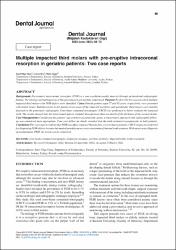Multiple impacted third molars with pre-eruptive intracoronal resorption in geriatric patients: Two case reports
Künye
Onay, E. O., Koç, C. ve Üngör, M. (2023). Multiple impacted third molars with pre-eruptive intracoronal resorption in geriatric patients: Two case reports. Dental Journal, 56(2), 68-72. https://dx.doi.org/10.20473/J.DJMKG.V56.I2.P68-72Özet
Background: Pre-eruptive intracoronal resorption (PEIR) is a rare condition usually detected through an incidental radiographic finding. The etiology and pathogenesis of this phenomenon are not fully understood. Purpose: To describe two cases in which multiple impacted third molars with PEIR defects were identified. Cases: Female patients aged 77 and 82 years, respectively, were presented with dental issues. Radiolucencies in the dental crown areas of the impacted maxillary and mandibular third molars were initially detected on the panoramic radiographs. Cone-beam computed tomography (CBCT) was performed to better evaluate the impacted teeth. The results showed that the intracoronal defects extended through more than two-thirds of the thickness of the coronal dentin. Case Managements: Considering the patients’ age and their asymptomatic status, a conservative approach with radiographic followup was considered most appropriate. Four-year follow-up checks revealed that the teeth remained asymptomatic in both patients. Conclusion: This case report confirms that PEIR can affect impacted third molars, even in elderly patients. CBCT images are preferred for diagnosing PEIR defects because this method provides an accurate assessment of internal tooth anatomy. With an accurate diagnosis of asymptomatic PEIR, the lesion can be monitored.
Scopus Q Kategorisi
Q4Kaynak
Dental JournalCilt
56Sayı
2Bağlantı
https://dx.doi.org/10.20473/J.DJMKG.V56.I2.P68-72https://hdl.handle.net/20.500.12511/10971
Koleksiyonlar
- Makale Koleksiyonu [568]
- Scopus İndeksli Yayınlar Koleksiyonu [6632]


















